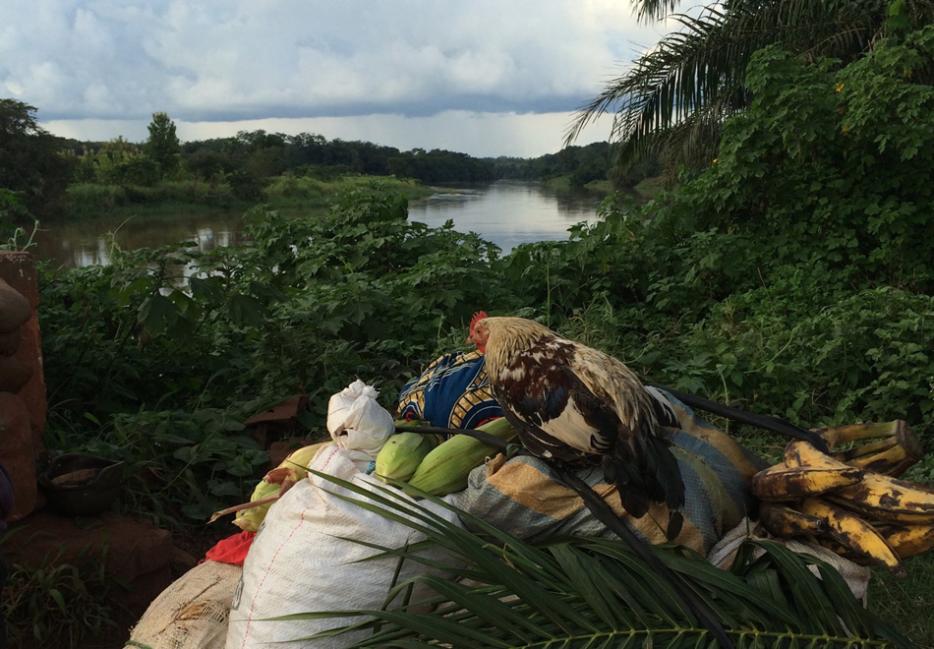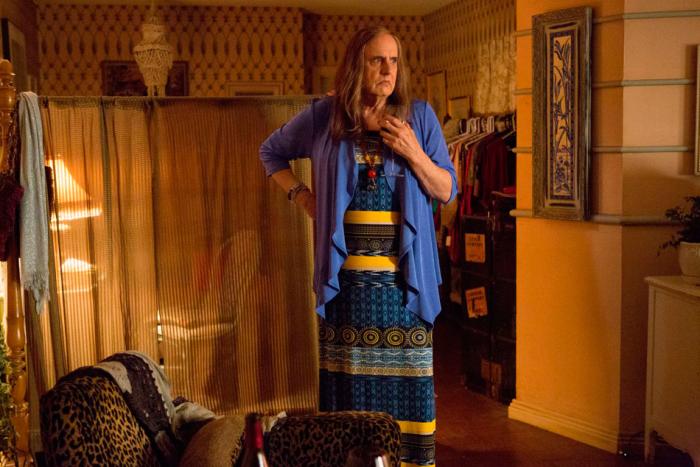The road out of Bangui runs through the PK12 market, a two-kilometre stretch of crazed commerce in which the last of the world’s garbage ends up for sale in stalls made of ragged tarpaulin. The market’s inevitable checkpoint is operated by the Muslim rebel group, Séléka, backed up by the French force, Sangaris. PK12 was once Bangui’s Muslim enclave, but then the war came, and the market became a flashpoint. Now, it belongs to the war. A young French soldier, outfitted like a model in a Chuck Norris fantasy catalogue, leans into our truck and barks, “Where?”
Our fixer, Rodrigue, hands him our puppy papers and says, “Bambari.”
The soldier rolls his eyes. He must know that we are on our way there to investigate claims by the Séléka that during a recent battle the French disarmed Muslims and “allowed” anti-balaka fighters to perpetrate a mini massacre. The allegations seem preposterous, but they’ve had a real impact on how the French have been forced to handle the conflict. Bambari, located in the middle of country, is a vital market town sliced in half by the vital Ouaka River. (Bambari, we’ll soon learn, is often paired with the adjective “vital,” which is why so many people have died trying to control it). The French refer to the city as the “fracture zone,” but it is not a stretch to call it a working metaphor for the Tenth Parallel, the line of longitude that divides the Muslim north from the Christian south, all the way from West Africa through to the Philippines. Twelve thousand kilometres of war, perfectly articulated by the Ouaka River’s heavily fortified bridge. Hundreds of PK12’s Muslims have been escorted to Bambari by the French over the course of this year, which from the vantage point of our 4x4 seems like a de facto partition of the country along religious lines.
A quick word on our 4x4: my colleague and I are not convinced that the truck will make the 380 km trip northwest. Its hindquarters drag like a pregnant raccoon’s, its tires look like they’ve been gummed by the world’s largest toddler. Rodrigue has told us that after the town of Sibut, 200 km or so from Bangui, the road becomes nearly unusable, churned into a loamy milkshake by all the military convoys. But if we hope to see Bambari, our choices are limited to this Franken-vehicle of no obvious provenance, or the offer of a lift with an NGO operating in the north.
In CAR a gun is not a gun, but a karmic boomerang that recognizes no master.
No NGOs are forthcoming, so off we go.
What does the countryside of the world’s second poorest country look like? A swamp of lassitude stirred only by the blades of a relief helicopter? Not at all. We pass ancient sedans jammed full of people and cargo, with more people and more cargo piled onto roofs, bonnets and trunks. Carts bearing lumber, CAR’s main (official) export, are pushed through the humidity by young men, long hardwood boughs jutting forth like the prows of Viking ships. We encounter village after village along a strip of asphalt cutting through the jungle. Then checkpoints manned—although manned is a misnomer—by anti-balaka soldiers five years away from their first shave. Any government-issued denials regarding the existence of child soldiers are rubbished the moment we leave Bangui. Rodrigue addresses them with the diminutive petit—little boy. These children are armed with ancient rifles that called bandaguikwa, an Ngbandi word meaning, “a man’s weapon can be the instrument of his own death.” In CAR a gun is not a gun, but a karmic boomerang that recognizes no master.
*
We do not, of course, make it to Bambari, but still count ourselves lucky to end up only 80 kms short of our objective. The truck dies in the mud, felled by three flat tires, and we arrive in the village of Grimari on the back of one of two miraculous taxi-motos that Rodrigue is able summon from a small village near from where we flatted. The night’s canopy of stars stretches above us, Scorpio never brighter, and we dodge potholes and sinkholes on the back of a 125cc bike that was not designed for anything nearly this rambunctious. We roll through the Grimari checkpoint shortly before midnight, and instantly draw the attention of two Sangaris battle vehicles. They drive out to welcome us, guns first.
CAR is big, but there are times when it feels no larger than a village. The captain of the Grimari camp calls Bangui to check on our credentials, and after he’s satisfied that we are who our paperwork says we are, we follow his men into town like a ragged procession en route to the world’s strangest rave. No one will give us a bed—our last and final hope is the Catholic mission, where a priest named Father Steffano Fazzion agrees to take us in.
The mission itself inhabits a huge plot at the far end of town, dominated by a church made from red brick and corrugated iron. Mini-villages have popped up outside the mission’s schoolhouses, with entire communities cooking or cleaning or fixing bicycles on school desks. Numerous NGOs have set up relief tents, and there is a line of bright white UNHCR privies abutting the bush.
Father Fazzion has been here for eight years, and he witnessed the beginning of the war, when the Seleka swept through town. From January to March 2013, the Muslim rebels camped in Grimari, waiting to invade the capital. Father Fazzion is a religious man (not all priests are, in my experience), but to him this is not a religious war. “The worst thing Seleka has done has been to separate people,” he tells us, during a mid-morning break from his duties. A precise man in his mid-thirties, Father Fazzion waited out the Seleka as he’d wait out any privation. “Always with the Muslims, with the Muslims. But this is not how Centrafrique has worked. For a long time, people did not see themselves divided in this way.”
The war, Fazzion tells us, is an economic war, “a war about money, and about power.” And it is not genocide, he insists. This is nothing more or less than the violence that arises out of a shambles of competing interests in which the very idea of governance runs contrary to the state’s raison d’etre. Chaos isn’t the result, but the point.
*
I will start this next section in medias res in order to save myself from recollecting the trip from Grimari to Bambari, hours of hell in a broken truck that by rights should never have appeared in the town square.. So let me just say that Bambari’s “fracture zone,” when it appears before us, is just a bridge, and the Ouaka River shimmers like something out of a naturalist’s dream. Foreign Legionnaires backstopped by the African Union’s MISCA troops scrutinize our puppy papers. A red earth square in the middle of town, ringed by red stained colonial-era buildings—Bambari could pass for capital of Mars, recently evacuated.
This is nothing more or less than the violence that arises out of a shambles of competing interests in which the very idea of governance runs contrary to the state’s raison d’etre. Chaos isn’t the result, but the point.
The truck brings us shakily into the MISCA camp, operated by a disciplined regiment from Gabon. Their commander, Captain Alex Cambot, is a charming man in his early thirties who seems to have modeled his impeccable manners on French war propaganda films from the ’40s.
“We are here just to protect civilians,” he tells us, gesturing toward the refugee camp that forms the heart of the compound. We are seated on his headquarters’ balcony, on patio furniture melting from the heat. “That is our job.” There are thousands of people living under his care, and we want to know whether he believes that the French have complicated matters in Bambari. More specifically, were they responsible for the bloodshed in the last several months by disarming Seleka and allowing anti-balaka free rein?
He smiles. “It is difficult to say what happened. Sangaris good, Sangaris bad—only Sangaris can say.”
Well, perhaps—but everyone has an opinion, including the local Séléka spokesperson, Captain Ahmat Nedjed Ibrahim. We meet him a few hours later in Bambari’s Muslim quarter, in a dark room deep in a warren of teetering concrete buildings. Captain Ibrahim is a fine-boned 25-year-old in an impressive djellaba, who greets us warmly but barely looks up from his laptop as we speak. He studied computing in university, he tells us. Now, he functions as Séléka’s intellectual warhead.
The young captain was radicalized in the old fashioned way—in 2011 he was thrown in a large sack with three other men. Francois Bozize’s soldiers peppered the sack with AK fire, and Ibrahim was the only person to emerge alive. “After that,” he tells us, “I know that Bozize is a monster.” And nothing has changed. Muslim flesh, he tells us, is being consumed by anti-balaka forces, cooked up in the market under the eye of the French. “It is from a feeling of very bad wickedness toward the Muslims,” he says.
According to Ibrahim, the massacre in Bambari was due to French and anti-balaka collusion. And yet his evidence is spotty, his explanations of how the events unfolded make no real sense. For the past few months, anti-balaka forces in Bambari have been determined to ethnically cleanse the city, pushing the Muslims further back toward the Tenth Parallel. What are the French to do when Bambari’s citizens are so determined to wipe each other out?
Moments later, one of Ibrahim’s charges brings in an AK-47 and a laptop, the tools of the modern insurgent. Behind us, piled high, DVDs and CDs, and computer equipment. On top of the pile, a Commando/Delta Force double feature. I have a brief pang of nostalgia for those films, for their stripped-down, ingrate simplicity. Then we are ushered into the sun, for pictures.
*
It’s almost dusk. We stroll through the red-hued city, down to the bridge, where the Foreign Legionnaires are stationed. On this side of the bridge, the Legionaires tell us, Seleka. On the other side of the bridge, anti-balaka. This is the way it works. This is what CAR will look like, does look like.
Moments later, one of Ibrahim’s charges brings in an AK-47 and a laptop, the tools of the modern insurgent. Behind us, piled high, DVDs and CDs, and computer equipment.
Our main interlocutor is a Moroccan Legionnaire whose name must be withheld for reasons that will become obvious. “Our mission here is to make sure that no one brings weapons over this bridge,” he tells us. He is sweating copiously under the weight of all his equipment—knives, guns, a Kevlar vest, more knives, a flashlight, gadgets I cannot identify. He tells us a little about life in the Foreign Legion, tells us that he’s three years into his five-year tour, and only eighteen percent of Legionnaires re-up their contracts. It’s hard work, he says, and nowhere harder than CAR.
“In Afghanistan, we have one enemy,” he explains. “The Taliban. Here, we have I don’t know how many.” And then the crux of the issue that haunts Bambari and therefore the entire conflict: the catastrophe of disarming the local Séléka, and the bloodshed that followed. But did the French actively collude with the anti-balaka?
He shakes his head wearily. “We took guns from Séléka,” he tells us, “and we had not the time to do the same with the Christians. Then the anti-balaka come from behind our backs and”—he makes a slashing motion across his throat. “Now, we don’t disarm anymore. No way. We just try to stop guns coming across the bridge.” The signature move of the war, and one of the events that blighted Sangaris in the eyes of the Central African people, was a blunder, a mistake. “They will kill you here because you have an extra line on your face,” the soldier says, grimly. “One day they try to kill you, the next day they smile and they are your friend. It is complicated. So complicated.”
CAR, it seems to us, is too broken to be fixed merely by standing on either end of a bridge. The more we look, the more CAR’s story appears to be just another in the larger tale of a balkanizing planet, a refutation of all the flat world theorists who believe that borders are disappearing. Only one fifth of CAR’s population is Muslim, and once they lived here in relative harmony with their neighbours. Like scar tissue developing over bad wounds, CAR is becoming overrun by keloids of partitions and dividing lines. This is the modern world’s defining tragedy: those who once lived together must now live apart. In this way, Bambari us not some atavistic hellhole in which a distant meaningless war plays itself out. It is instead a convincing representation of the future.






